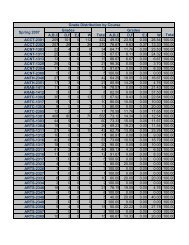Photo Lab Manual (PDF) - Richland College
Photo Lab Manual (PDF) - Richland College
Photo Lab Manual (PDF) - Richland College
You also want an ePaper? Increase the reach of your titles
YUMPU automatically turns print PDFs into web optimized ePapers that Google loves.
Roy's Guide to Infrared <strong>Photo</strong>graphyFacts:A. Both color and black and white infrared films have emulsions that are sensitizedto infrared radiation along with a portion of the visible light spectrum. Use of afilter over the camera lens or light source controls the amount of visible lightreaching the film.B. Infrared film can be used with electronic flash, tungsten photo lamps or daylight.C. Infrared films are primarily designed for use in the scientific fields of photography,medicine, plant pathology, ecology, archeology, and laser photography. In additionto these uses, infrared can be used for pictorial and other non-technicalforms of photography (such as fine art). Landscape photography has a highdegree of clarity because infrared film penetrates much of the haze that obscuresphotos of distant scenes taken with ordinary films. Infrared film also shows contrastbetween subject matter where none may exist visually. This is especially truewhen shooting foliage that usually appears light-toned in black and white or redand magenta with color infrared.D. Black and white infrared film alters the reproduction of tones as compared toconventional panchromatic films. Live foliage, which reproduces as dark gray toneson panchromatic films, becomes light tones on infrared. Blue skies and bodies ofwater appear black or dark in infrared photos.Myths:Some people are under the impression that a camera loaded with infrared film can be used totake perfectly exposed pictures in total darkness. This is not the case. Just as with ordinaryfilms, a source of illumination is needed to record a scene with a camera.The energy awareness that has occurred in the past few years has produced public interest inphotos showing heat loss of homes and buildings, called thermograms. Many people are ledto believe that thermograms can be made by using only infrared film and conventional photoequipment. Thermograms are produced by using infrared radiation and sophisticated electronicequipment. Infrared film is no more sensitive to moderate levels of heat than conventionalphotographic films.58
















